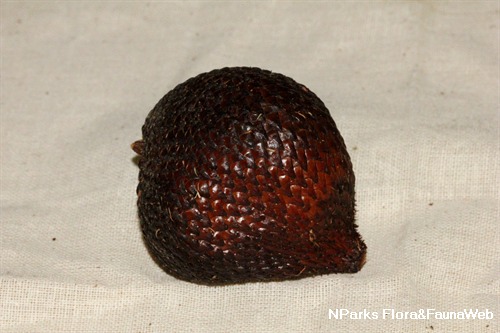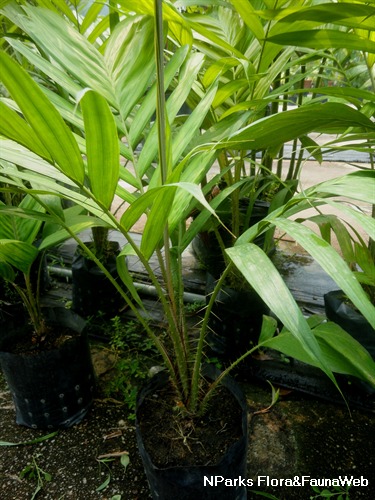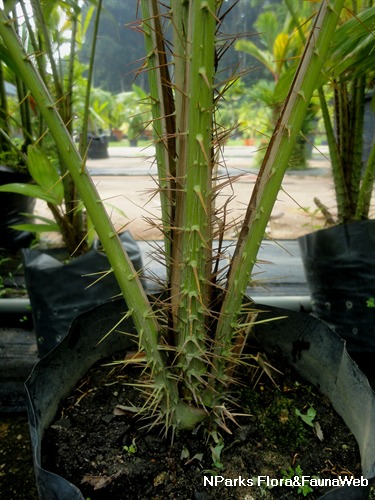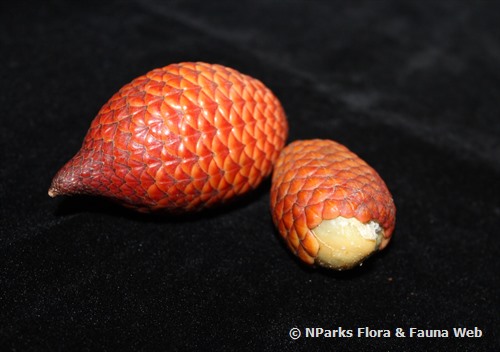
Back
Salacca zalacca (Gaertn.) Voss
| Family Name: | Arecaceae (Palmae) |
| Common Name: | Salak, Snake Fruit, 蛇皮果 |
Name
Classifications and Characteristics
| Plant Division | Angiosperms (Flowering Seed Plants) |
|---|---|
| Plant Growth Form | Palm (Clustered Habit) |
Biogeography
| Native Distribution | Sumatra |
|---|---|
| Native Habitat | Terrestrial |
| Preferred Climate Zone | Tropical |
Description and Ethnobotany
| Growth Form | Salacca zalacca is a densely clustering palm with short and stout stems which may appear stemless (acaulescent). |
|---|---|
| Foliage | The leaves are large (3 – 7 m long), pinnate and arching with spiny petioles. Leaflets are long, dark green above and sliver-green beneath. Leaflets grow from the rachis in an almost flat plane, but are arranged into closely set groups of 3 -5. Leaflets are long, narrowly elliptic, dark green above and silvery green beneath. |
| Flowers | Female inflorescence (20 – 30 cm long) comprise of 1 – 3 spadices which are 7 – 10 cm long. Male inflorescence (50—100 cm long) comprise of 4 – 12 spadices which are 7 – 15 cm long. Male flowers have reddish tubular corolla and 6 stamens on the corolla throat, while female flowers have tubular corolla which are yellow green outside and dark red inside, with a red style. |
| Fruit | The fruit is a round to elliptical drupe, covered in imbricate scales which turn reddish brown to nearly red when ripe. Seeds are fleshy and usually occurs 3 per fruit. |
| Habitat | Salacca zalacca grows in low land rainforest and swamps, often forming impenetrable thickets. |
| Cultivation | Fresh seed kernels germinate in less than a week under moist, shady conditions, even on top of the soil. |
| Ethnobotanical Uses | Edible Plant Parts : Edible Fruits Food (Fruit or Vegetable): Matured fruits of Salacca zalacca can be eaten fresh, canned, candied ('manisan salak') or pickled ('asinan salak'). Unripe fruits are also used in 'rujak', a spicy salad. Fruit is quite sweet when fully ripe, but unripe fruit is sour and astringent due to the small presence of tannic acid. Ripe fruit taste like a combination of apple, pineapple and banana. Leaflets are used for thatching while bark of the petioles are used for matting. |
Landscaping Features
| Desirable Plant Features | Ornamental Fruits |
|---|---|
| Landscape Uses | Parks & Gardens |
Fauna, Pollination and Dispersal
| Pollination Method(s) | Biotic (Fauna) |
|---|
Plant Care and Propagation
| Light Preference | Semi-Shade, Full Shade |
|---|---|
| Water Preference | Lots of Water |
| Plant Growth Rate | Moderate |
| Propagation Method | Seed |
Foliar
| Mature Foliage Colour(s) | Green |
|---|---|
| Foliar Shape(s) | Palm Fronds (Pinnate / Feather) |
Floral (Angiosperm)
| Flower Colour(s) | Cream / Off-White, Green - Light Green, Red |
|---|---|
| Flower Grouping | Cluster / Inflorescence |
Fruit, Seed and Spore
| Mature Fruit Colour(s) | Brown, Red |
|---|---|
| Mature Fruit Texture(s) | Scaly |
Image Repository
Others
| Master ID | 1997 |
|---|---|
| Species ID | 3289 |
| Flora Disclaimer | The information in this website has been compiled from reliable sources, such as reference works on medicinal plants. It is not a substitute for medical advice or treatment and NParks does not purport to provide any medical advice. Readers should always consult his/her physician before using or consuming a plant for medicinal purposes. |




_lowres.jpg)

